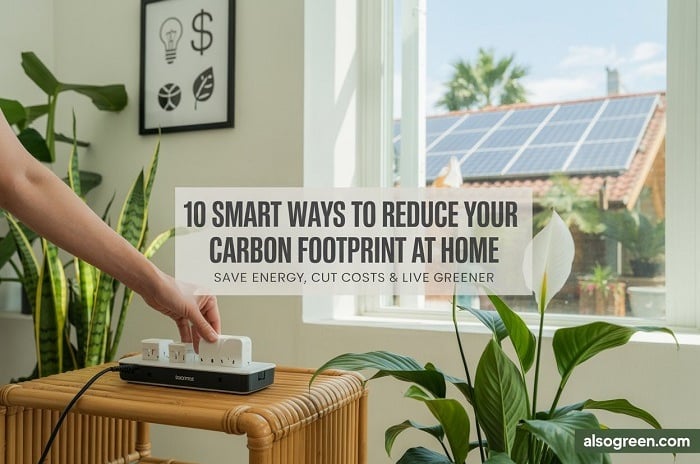How to Reduce Your Carbon Footprint at Home
Learn how to reduce your carbon footprint at home with practical, eco-friendly tips—from energy-saving appliances to daily habits. Build a greener, healthier lifestyle with simple changes that make a big impact.


10 Smart Ways to Reduce Your Carbon Footprint at Home: Save Energy & Money
We often hear about "reducing our carbon footprint," but what does that truly mean for our everyday lives? Put, your carbon footprint is the amount of carbon dioxide and other greenhouse gases you release through your daily choices – from the energy powering your home to the food on your plate.
The excellent news? You don't need a complete lifestyle overhaul to make a significant difference. This comprehensive guide outlines 10 smart, practical changes you can implement right at home to substantially lower your emissions, slash your energy bills, and create a more comfortable, eco-conscious living space.
Understanding Home Energy Conservation: Why Your Choices Matter
1. Upgrade to Energy-Efficient Appliances: The Smart Investment
Still, using that old refrigerator or washing machine? It's likely a significant energy guzzler. ENERGY STAR-certified appliances can cut energy consumption by up to 50% compared to outdated models.
Why it matters: Lower utility bills, longer appliance lifespan, reduced strain on the power grid.
💡 Pro Tip: Even smaller appliances, such as toasters and microwaves, now come in energy-saving versions.
🛒 Smart Pick: When shopping, look for ENERGY STAR-certified models.
2. Insulate and Weatherproof Your Home: Sealing in Savings
A poorly insulated home is like a leaky bucket, losing heat in winter and cool air in summer – leading to higher emissions and inflated bills. Proper insulation and weather stripping can reduce heating and cooling needs by up to 20%.
What to do: Seal windows and door gaps, add attic and wall insulation, and install thermal curtains.
🏡 Eco upgrades often qualify for tax credits or government rebates – check your local programs for eligibility.
3.Switch to LED Lighting: Bright Ideas, Lower Bills
Still using incandescent bulbs? Make the switch to LEDs. They use up to 80% less energy and last significantly longer – often 10 times longer!
Benefits: Dramatically lower electric bills, less frequent replacements, cooler (temperature-wise) lighting.
💡 Impact Fact: A single LED bulb can save $50 or more over its lifetime. Imagine the savings multiplied across your entire home!
4.Embrace Renewable Energy: Powering Your Home Green (Even as a Renter!)
Many utility companies now offer "green energy" plans, allowing you to power your home with wind, solar, or hydro – often without needing to install your panels.
Options to explore: Solar subscription services, community solar farms, and green electricity add-ons from your existing provider.
🔌 For Homeowners: Installing solar panels can reduce your carbon footprint by over 3 tons annually and often increases property value.
5.Sustainable Living Tips for Everyday Use: Small Changes, Big Impact
Want a Pinterest-worthy home and a cleaner conscience?
Change Your Daily Habits: Free Ways to Cut Emissions
You don't need to buy anything new to start reducing emissions today. These minor, consistent habit tweaks make a significant difference:
✅ Unplug devices when not in use to prevent phantom load.
✅ Air-dry laundry whenever possible.
✅ Cook with lids on pots and pans to save energy.
✅ Use cold water for washing clothes.
✅ Turn off lights when leaving. When shopping, look around.
📉 ImpSTAR-certified: Change your household energy use by 10–15% over time.
Your home can be stylish and sustainable. Check out our guide on eco-friendly home decor ideas for more inspiration.
6.Eco-Friendly Cooking & Eating: Greening Your Kitchen
Your kitchen plays a dual role in energy consumption and carbon-heavy choices.
Try these greener alternatives:
🥕 Eat more plant-based meals: Reducing meat consumption significantly lowers your dietary carbon footprint.
🍽 Compost food scraps: Divert organic waste from landfills.
🧊 Store leftovers in reusable containers: Ditch single-use plastic wrap and foil.
🔥 Consider induction cooktops: They are highly energy-efficient for cooking.
📌 Resource: Check out our post: Zero-Waste Kitchen Hacks You'll Use
For more hacks, see our post on zero-waste kitchen tips.
7.Make Smarter Home Décor Choices: Style with a Conscience
Creating a stylish home doesn't have to come at the expense of the planet. Your furniture and décor can either contribute to environmental harm or actively help mitigate it.
🪑 Choose: Reclaimed wood or bamboo furniture, organic cotton/linen/hemp fabrics, or second-hand finds from thrift stores.
🎯 Bonus: Sustainable items often boast more character and durability than mass-produced "fast-furniture" pieces.
8.Add Indoor Plants That Clean the Air: Natural Air Purifiers
Plants aren't just for aesthetics – they're natural air purifiers that actively contribute to a healthier home environment.
Best indoor plants to reduce toxins: Snake Plant, Spider Plant, Peace Lily, Areca Palm.
These plants absorb carbon dioxide, improve indoor air quality, and bring a peaceful, natural vibe to your living space.
9.Install Low-Flow Fixtures: Conserving Water, Saving Energy
Water usage inherently involves energy usage, especially when heating water. Low-flow faucets, showerheads, and toilets significantly cut both water and power consumption.
Benefits: Up to 60% less water use, lower water heating bills, and reduced strain on public water systems.
🚿 Impact Fact: A low-flow showerhead can save over 2,700 gallons per year – that's good for your wallet and the planet.
10.Buy Less, Choose Wisely, Reuse More: The Ultimate Carbon Reducer
Excessive consumerism is a significant contributor to household emissions. Reducing your consumption and making mindful purchasing choices has a greater impact than you might think.
🛍️ Tips: Buy quality items that last, avoid single-use plastics, repurpose and upcycle old materials, and support eco-conscious brands.
♻️ Product Inspiration: Browse our Eco Finds Section for vetted sustainable products.
FAQs: Real Answers for Real People
Q1: What's the fastest way to cut emissions at home?
A: Start with LED lighting, unplugging electronics when not in use, and actively working to reduce food waste. These changes are free or low-cost and offer immediate impact.
Q2: Is switching to solar worth it for my home?
A: Yes, if you own your home and reside in a sunny region, installing solar panels is often a sound investment. It drastically reduces emissions and can increase your property value.
Q3: Can renters still make a significant impact on their carbon footprint?
A: Absolutely! Renters can make a substantial difference by using smart bulbs, utilising power strips for easy unplugging, opting for reusable products, and exploring green energy plans offered by their utility provider.
Q4: Do indoor plants truly clean the air in my home?
A: Yes! NASA studies have shown that certain indoor plants are effective at removing common indoor air toxins and improving overall air quality.
Q5: How do I know if my electricity is sourced from clean energy?
A: Check your energy bill for details on your energy mix, or contact your electricity provider directly to inquire about their green energy plans and to confirm your enrollment.
Conclusion: Build a Home That Reflects Your Values
Lowering your carbon footprint doesn't mean sacrificing comfort or convenience. It's about making more thoughtful, more informed decisions – the kind that brings tangible benefits to you, your finances, and the health of our planet.
Start with just one of the ideas above and gradually build from there. Before you know it, your home will be a beacon of eco-conscious living, inspiring others to embark on their sustainable journey.
👉 Want more sustainable home tips? Visit alsogreen.com and explore our growing library of green guides and affordable eco-products.
Also Green
Embrace a mindful and eco-friendly lifestyle today.
Contact
contact@alsogreen.com
© 2025 Also Green. All Rights Reserved
+14706521930
